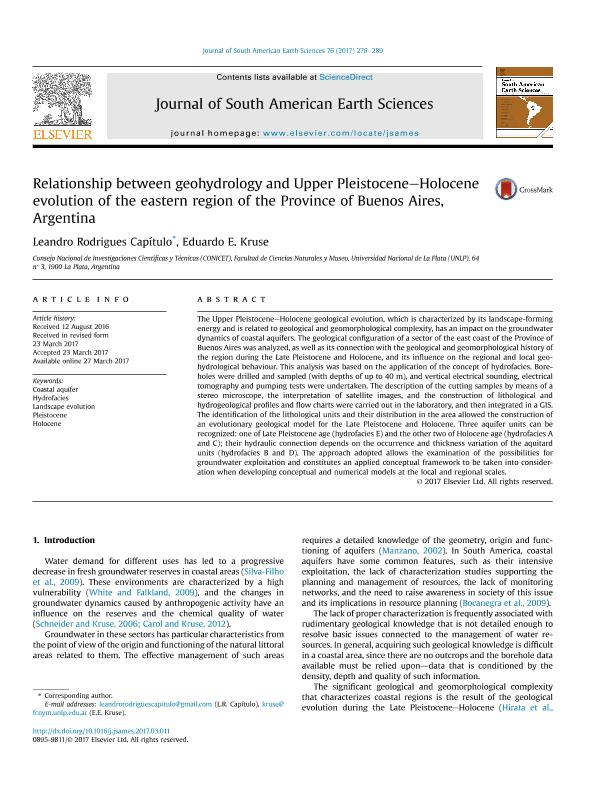Mostrar el registro sencillo del ítem
dc.contributor.author
Rodrigues Capitulo, Leandro

dc.contributor.author
Kruse, Eduardo Emilio

dc.date.available
2018-08-21T21:11:41Z
dc.date.issued
2017-07
dc.identifier.citation
Rodrigues Capitulo, Leandro; Kruse, Eduardo Emilio; Relationship between geohydrology and Upper Pleistocene-Holocene evolution of the eastern region of the Province of Buenos Aires, Argentina; Pergamon-Elsevier Science Ltd; Journal of South American Earth Sciences; 76; 7-2017; 276-289
dc.identifier.issn
0895-9811
dc.identifier.uri
http://hdl.handle.net/11336/56477
dc.description.abstract
The Upper Pleistocene-Holocene geological evolution, which is characterized by its landscape-forming energy and is related to geological and geomorphological complexity, has an impact on the groundwater dynamics of coastal aquifers. The geological configuration of a sector of the east coast of the Province of Buenos Aires was analyzed, as well as its connection with the geological and geomorphological history of the region during the Late Pleistocene and Holocene, and its influence on the regional and local geohydrological behaviour. This analysis was based on the application of the concept of hydrofacies. Boreholes were drilled and sampled (with depths of up to 40 m), and vertical electrical sounding, electrical tomography and pumping tests were undertaken. The description of the cutting samples by means of a stereo microscope, the interpretation of satellite images, and the construction of lithological and hydrogeological profiles and flow charts were carried out in the laboratory, and then integrated in a GIS. The identification of the lithological units and their distribution in the area allowed the construction of an evolutionary geological model for the Late Pleistocene and Holocene. Three aquifer units can be recognized: one of Late Pleistocene age (hydrofacies E) and the other two of Holocene age (hydrofacies A and C); their hydraulic connection depends on the occurrence and thickness variation of the aquitard units (hydrofacies B and D). The approach adopted allows the examination of the possibilities for groundwater exploitation and constitutes an applied conceptual framework to be taken into consideration when developing conceptual and numerical models at the local and regional scales.
dc.format
application/pdf
dc.language.iso
eng
dc.publisher
Pergamon-Elsevier Science Ltd

dc.rights
info:eu-repo/semantics/openAccess
dc.rights.uri
https://creativecommons.org/licenses/by-nc-nd/2.5/ar/
dc.subject
Coastal Aquifer
dc.subject
Holocene
dc.subject
Hydrofacies
dc.subject
Landscape Evolution
dc.subject
Pleistocene
dc.subject.classification
Paleontología

dc.subject.classification
Ciencias de la Tierra y relacionadas con el Medio Ambiente

dc.subject.classification
CIENCIAS NATURALES Y EXACTAS

dc.title
Relationship between geohydrology and Upper Pleistocene-Holocene evolution of the eastern region of the Province of Buenos Aires, Argentina
dc.type
info:eu-repo/semantics/article
dc.type
info:ar-repo/semantics/artículo
dc.type
info:eu-repo/semantics/publishedVersion
dc.date.updated
2018-08-21T18:39:31Z
dc.journal.volume
76
dc.journal.pagination
276-289
dc.journal.pais
Estados Unidos

dc.description.fil
Fil: Rodrigues Capitulo, Leandro. Universidad Nacional de La Plata. Facultad de Ciencias Naturales y Museo. Cátedra de Hidrología General; Argentina. Consejo Nacional de Investigaciones Científicas y Técnicas; Argentina
dc.description.fil
Fil: Kruse, Eduardo Emilio. Universidad Nacional de La Plata. Facultad de Ciencias Naturales y Museo. Cátedra de Hidrología General; Argentina. Consejo Nacional de Investigaciones Científicas y Técnicas; Argentina
dc.journal.title
Journal of South American Earth Sciences

dc.relation.alternativeid
info:eu-repo/semantics/altIdentifier/doi/http://dx.doi.org/10.1016/j.jsames.2017.03.011
dc.relation.alternativeid
info:eu-repo/semantics/altIdentifier/url/https://www.sciencedirect.com/science/article/pii/S089598111630147X
Archivos asociados
